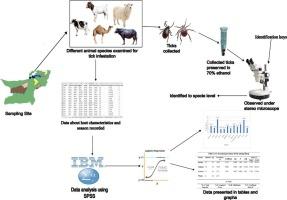巴基斯坦俾路支省选定地区牲畜中蜱虫流行情况的空间和季节分析
IF 1.4
Q3 PARASITOLOGY
Veterinary parasitology, regional studies and reports
Pub Date : 2025-10-01
DOI:10.1016/j.vprsr.2025.101357
引用次数: 0
摘要
蜱虫是一种体外寄生虫,以家畜的血液为食,导致体重、产奶量和兽皮质量显著下降。它们也是引起动物疾病的各种病原体的载体。本研究旨在调查俾路支省12个地区家畜(牛、山羊、绵羊、水牛和骆驼)中蜱虫的流行情况和种类分布。对759只家畜进行仔细检查,用手和钳采集蜱虫。收集的样品在70%乙醇中精心保存并适当标记。308只蜱属分别为透明蜱属(74.2%)和鼻头蜱属(25.9%),斑点蜱属、斑点蜱属、挖掘蜱属、绢毛蜱属、尾尾蜱属、环纹蜱属和血尾蜱属7种。蜱总流行率为41.37%(314/759),其中以牛最高(57.14%),其次为山羊(40.93%)、绵羊(32.18%)、水牛(32%)和骆驼(25.66%)。蜱虫侵害与寄主性别、年龄、品种、畜群类型、面积、季节等因素有显著相关性(p < 0.05)。高蜱虫负担会影响动物生产力,并增加蜱传疾病传播的可能性。这项研究的结果将有助于在地方和全球各级制定和实施这些寄生虫的控制措施。本文章由计算机程序翻译,如有差异,请以英文原文为准。

Spatial and seasonal analyses of tick prevalence in livestock across selected districts of Balochistan, Pakistan
Ticks are ectoparasites that feed on the blood of domestic animals, resulting in significant reductions in weight, milk production, and hide quality. They are also vectors of a variety of pathogens that cause disease in animals. This study aimed to investigate the prevalence and species distribution of ticks among domestic animals (cattle, goats, sheep, buffaloes, and camels) across 12 districts of Baluchistan. A total of 759 domestic animals were carefully examined, and ticks were collected using hand and forceps. The collected samples were meticulously preserved in 70 % ethanol and appropriately labelled. All 308 collected ticks belong to two genera, Hyalomma (74.2 %) and Rhipicephalus (25.9 %), and seven species: H. anatolicum, H. scupense, H. excavatum, H. dromedarii, R. appendiculatus, R. annulatus, and R. sanguineus sensu lato. The overall tick prevalence was 41.37 % (314/759), with the highest prevalence recorded in cattle (57.14 %), followed by goats (40.93 %), sheep (32.18 %), buffaloes (32 %), and camels (25.66 %). There were significant (p < 0.05) associations between tick infestation and factors, including host sex, age, breed, herd type, area, and season. A high tick burden impact animal productivity and increases the likelihood of tick-borne disease transmission. The findings of this study will help in the development and implementation of control measures for these parasites at the local and global levels.
求助全文
通过发布文献求助,成功后即可免费获取论文全文。
去求助
来源期刊
CiteScore
2.90
自引率
7.10%
发文量
126
审稿时长
97 days
期刊介绍:
Veterinary Parasitology: Regional Studies and Reports focuses on aspects of veterinary parasitology that are of regional concern, which is especially important in this era of climate change and the rapid and often unconstrained travel of people and animals. Relative to regions, this journal will accept papers of the highest quality dealing with all aspects of disease prevention, pathology, treatment, epidemiology, and control of parasites within the field of veterinary medicine. Also, case reports will be considered as they add to information related to local disease and its control; such papers must be concise and represent appropriate medical intervention. Papers on veterinary parasitology from wildlife species are acceptable, but only if they relate to the practice of veterinary medicine. Studies on vector-borne bacterial and viral agents are suitable, but only if the paper deals with vector transmission of these organisms to domesticated animals. Studies dealing with parasite control by means of natural products, both in vivo and in vitro, are more suited for one of the many journals that now specialize in papers of this type. However, due to the regional nature of much of this research, submissions may be considered based upon a case being made by the author(s) to the Editor. Circumstances relating to animal experimentation must meet the International Guiding Principles for Biomedical Research Involving Animals as issued by the Council for International Organizations of Medical Sciences (obtainable from: Executive Secretary C.I.O.M.S., c/o W.H.O., Via Appia, CH-1211 Geneva 27, Switzerland).

 求助内容:
求助内容: 应助结果提醒方式:
应助结果提醒方式:


